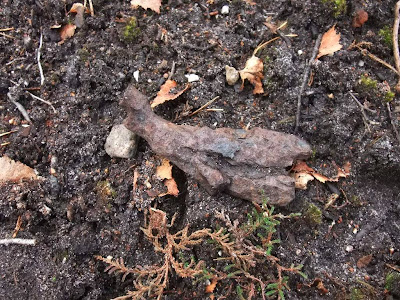Spent yesterday mapping at Westleton. By the end of March I hope to have the main Kruschen site mapped at Westleton so may be able to start making some sense of the data collected so far. However I will probably not have time to map the bit of the Kruschen site remaining at Dunwich. There will also be mapping to complete at Westleton in areas not part of the Kruschen site.
Three features of some curiosity mapped today.
Firstly three pits created by deepening an existing old boundary ditch. I am not sure of the age of the boundary ditch but it is certainly not any time recently!
Above: Map of a crawl trench system along with three pits dug by deepening an existing boundary ditch (shown by the dotted line). The crawl trench is of interest in that its is the first I've seen which incorporates a V shaped weapons-slit. Photo shows pit dug in existing boundary ditch.
Secondly a series of slits dug alongside the anti-tank ditch.
Above: Plot of slits alongside the anti-tank ditch. Photo shows one of the slits and the anti-tank ditch. This section of the ditch was not dug as part of Kruschen but was excavated in early 1941 and ran from Minsmere to Dunwich.
Thirdly, when I went to map what I thought were only two slits that I had found previously, I ended up mapping 21! It just goes to show how easily they can be missed and the value of repeat visits. What puzzles me is the layout - I cannot see what it was hoped to achieve in training with them (except possibly just giving troops a chance to dig a 6 ft X 2 ft slit). They are way too close together to represent any kind of unit defence post or even for PAD. The ground was certainly shelled during live firing exercises (as the shell fragment shows) but presumably not when these slits were being dug! This is going to be the biggest headache when it comes to making sense of the data - deciding which earthworks were part of Exercise Kruschen and which were not. For the vast majority of the one or two man slits I've mapped to date, it will probably not be possible to come to a conclusion! Even so I think it still of value to map what is in effect the remains of a major training area, more or less undisturbed since the end of the War.
Above: Plot of 21 slits, which I can make no sense of the layout. Two photos show my bag in one of the slits, showing just how well preserved some of them are. Last photo shows a fragment of shell, indicating live firing in the area.
Finally thanks to all who have viewed the blog / website (which has now had 21,000 hits!!) and wishing you all the best for the New Year.








Comments
Post a Comment